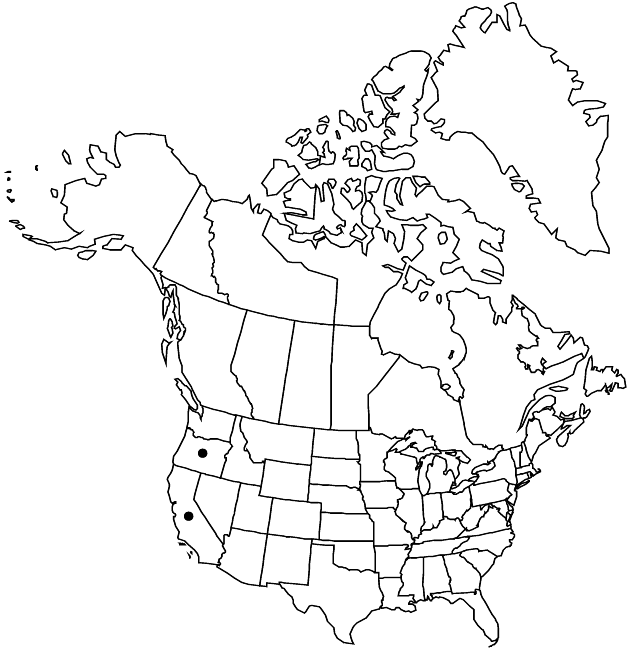Difference between revisions of "Antennaria suffrutescens"
Pittonia 3: 277. 1898.
FNA>Volume Importer |
imported>Volume Importer |
||
| (6 intermediate revisions by 2 users not shown) | |||
| Line 8: | Line 8: | ||
}} | }} | ||
|common_names=Evergreen or everlasting pussytoes | |common_names=Evergreen or everlasting pussytoes | ||
| + | |special_status={{Treatment/ID/Special_status | ||
| + | |code=E | ||
| + | |label=Endemic | ||
| + | }} | ||
|basionyms= | |basionyms= | ||
|synonyms= | |synonyms= | ||
| Line 24: | Line 28: | ||
|elevation=500–1600 m | |elevation=500–1600 m | ||
|distribution=Calif.;Oreg. | |distribution=Calif.;Oreg. | ||
| − | |discussion=<p>Antennaria suffrutescens is characterized by suffrutescent growth form, relatively small, emarginate, adaxially glabrous, coriaceous leaves, and relatively large heads borne singly. It is known only from serpentine soils in open montane pine forests in Curry and Josephine counties, Oregon, and neighboring Del Norte and Humboldt counties, California (R. J. Bayer and G. L. Stebbins 1987). Antennaria suffrutescens may have contributed to the origin of some of the clones of the A. rosea complex (e.g., J. T. Howell 27718, NY).</p> | + | |discussion=<p><i>Antennaria suffrutescens</i> is characterized by suffrutescent growth form, relatively small, emarginate, adaxially glabrous, coriaceous leaves, and relatively large heads borne singly. It is known only from serpentine soils in open montane pine forests in Curry and Josephine counties, Oregon, and neighboring Del Norte and Humboldt counties, California (R. J. Bayer and G. L. Stebbins 1987). <i>Antennaria suffrutescens</i> may have contributed to the origin of some of the clones of the <i>A. rosea</i> complex (e.g., J. T. Howell 27718, NY).</p> |
|tables= | |tables= | ||
|references= | |references= | ||
| Line 33: | Line 37: | ||
-->{{#Taxon: | -->{{#Taxon: | ||
name=Antennaria suffrutescens | name=Antennaria suffrutescens | ||
| − | |||
|authority=Greene | |authority=Greene | ||
|rank=species | |rank=species | ||
| Line 47: | Line 50: | ||
|publication title=Pittonia | |publication title=Pittonia | ||
|publication year=1898 | |publication year=1898 | ||
| − | |special status= | + | |special status=Endemic |
| − | |source xml=https:// | + | |source xml=https://bitbucket.org/aafc-mbb/fna-data-curation/src/2e0870ddd59836b60bcf96646a41e87ea5a5943a/coarse_grained_fna_xml/V19-20-21/V19_660.xml |
|tribe=Asteraceae tribe Gnaphalieae | |tribe=Asteraceae tribe Gnaphalieae | ||
|genus=Antennaria | |genus=Antennaria | ||
Latest revision as of 20:54, 5 November 2020
Dioecious. Plants 5–12 cm (densely tufted, bases woody; root crowns relatively slender). Stolons none. Basal leaves absent at flowering. Cauline leaves spatulate, 5–12 × 2–4 mm, not flagged (apices emarginate or obtuse, abaxial faces tomentose, adaxial green). Heads borne singly. Involucres: staminate 5–9 mm; pistillate 10–15 mm. Phyllaries (relatively wide) distally white. Corollas: staminate 4–5 mm; pistillate 5–8 mm. Cypselae 1–2 mm, papillate; pappi: staminate 4.5–5.5 mm; pistillate 7–9 mm. 2n = 28.
Phenology: Flowering early summer.
Habitat: Dry, open coniferous woods or barren slopes on serpentine
Elevation: 500–1600 m
Discussion
Antennaria suffrutescens is characterized by suffrutescent growth form, relatively small, emarginate, adaxially glabrous, coriaceous leaves, and relatively large heads borne singly. It is known only from serpentine soils in open montane pine forests in Curry and Josephine counties, Oregon, and neighboring Del Norte and Humboldt counties, California (R. J. Bayer and G. L. Stebbins 1987). Antennaria suffrutescens may have contributed to the origin of some of the clones of the A. rosea complex (e.g., J. T. Howell 27718, NY).
Selected References
None.
